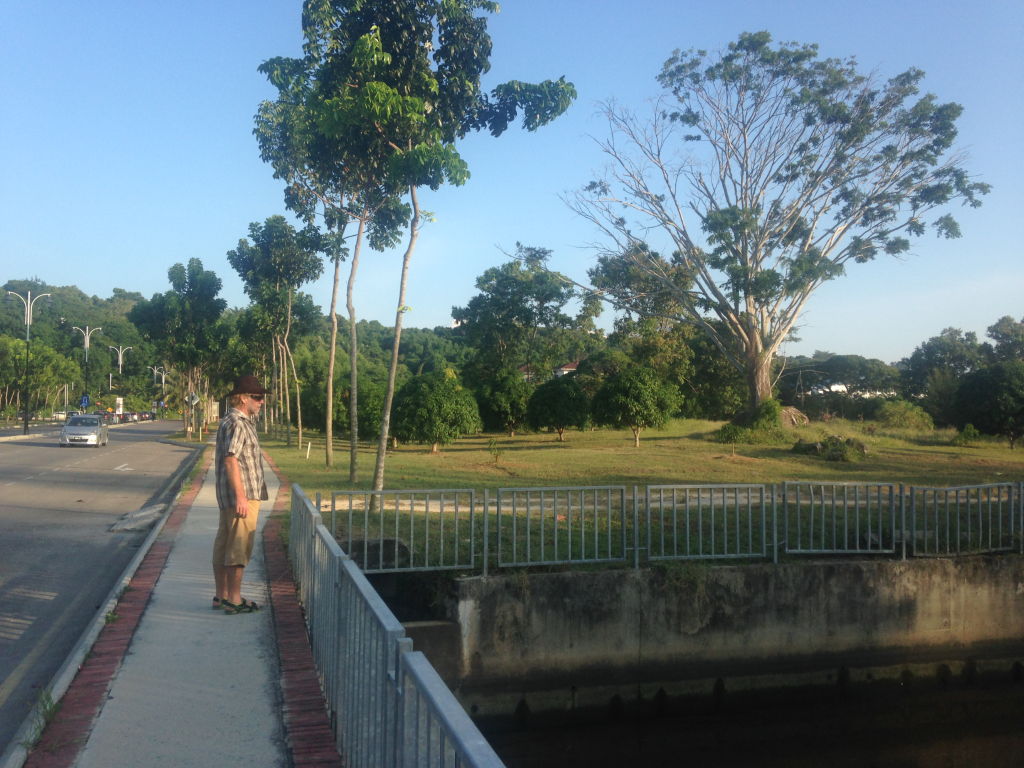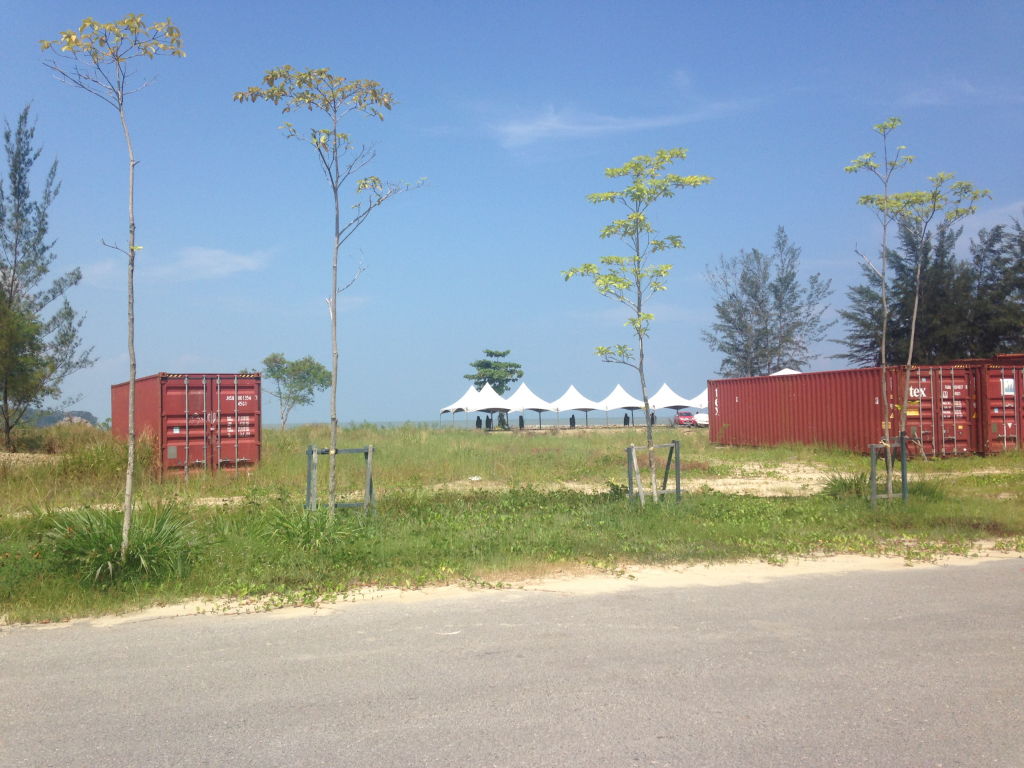It’s almost time for us to return to Sister Midnight. She has been in her berth at Miri Marina in North Borneo since we left her at the end of July for our two-month break in the UK. Before we embark on enjoying further excursions and experiences, I am keen to complete the blog posts for the last few weeks in July. Due to intermittent Wifi and lack of time, I was unable to submit any entries or pictures before we left. They follow below and, typing as I am in a very ‘autumnal’ Merseyside, will help prepare me for the heat, sun and humidity that await us in Malaysia, not to mention the wildlife, the food and new destinations: I can hardly wait 🙂
A FAIRY CAVE, A STREET MARKET AND A CROCODILE!
The attraction known as ‘Fairy Cave’ is located about 40km from Kuching and is another ‘must see’ on the list of recommended places in Sarawak. It’s near a place called Bau, a former gold mining settlement, and is also close to the site of a weekend street market we were keen to visit on the border with Indonesia. To fit all this in, we were up and out by 9am, the satnav programmed with directions for the 90 minute drive. Like several of the places we’ve visited, it looked deserted and closed when we got there but the kiosk was manned and we were issued with tickets (thankfully without the offer of a ‘senior rate’ this time) and directions. The view at the entrance didn’t convey a very promising impression. Access to the cave is via a four storey concrete staircase, much like those in multi-storey carparks. To the right of it we could see the original, now disused, staircase which was cut into the steep rock face. This one had no barrier and some of the steps were crumbing but a passing guide informed us that it had been used as recently as a few decades ago – without handrails even then!


At the top of the stairs we passed through a dim, narrow passage and ascended some steep wooden steps. At the end of the passage we found ourselves inside the mountain itself. The massive cave had a huge opening, which allowed the light to flood in and the scene before us was the stuff of fairy tales…or Harry Potter, Gormenghast, Lord of the Rings, Hall of the Mountain King – take your pick! Anyway, there were plenty of ‘wow’ moments in there, and all of it was natural. The cave is criss-crossed with concrete footpaths and steps and the slimy walls were covered in plants, ferns, and flowers. Stalactites and stalagmites abounded and some were almost meeting in the middle.



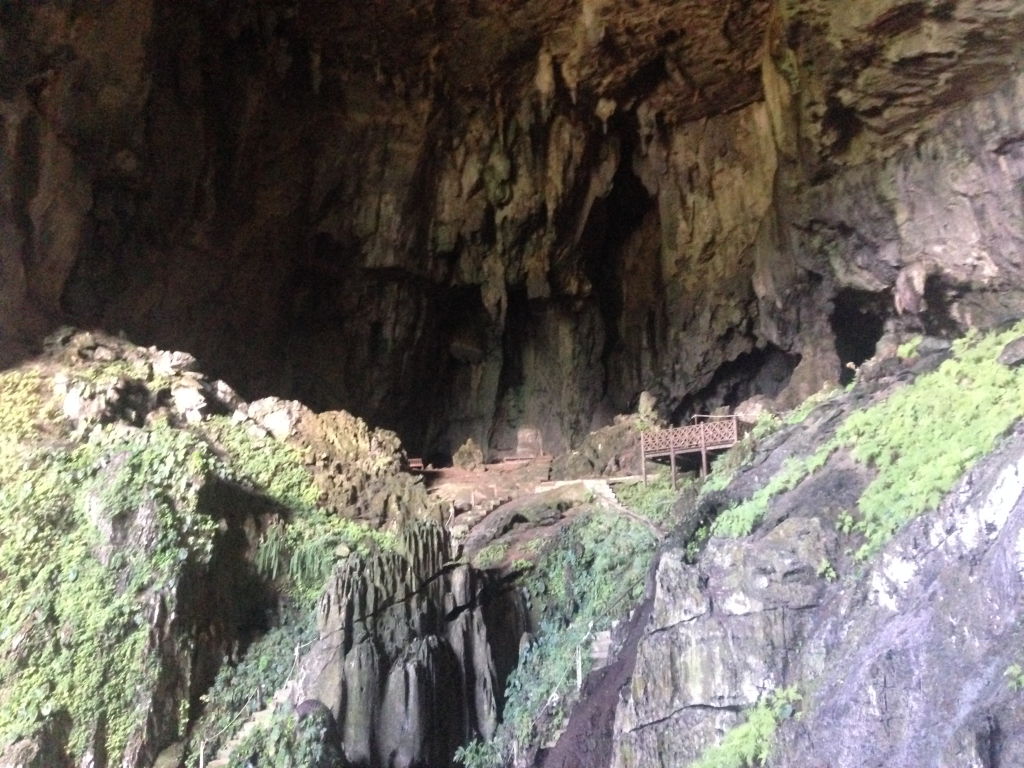
We could hear bats above us near the roof of the cave but I didn’t spot one. The ‘fairy’ that gives its name to the cave was rather understated when we came upon it. It was a tacky-looking statue that seemed to have been randomly plonked on a flat rock surface in the main cavern, as if to justify the name. I haven’t been able to find any definitive story about it anyway. Few other visitors were around and we had a delightful time exploring nooks and crannies and admiring the view of the fields and hills from the openings high up on the cave floor.
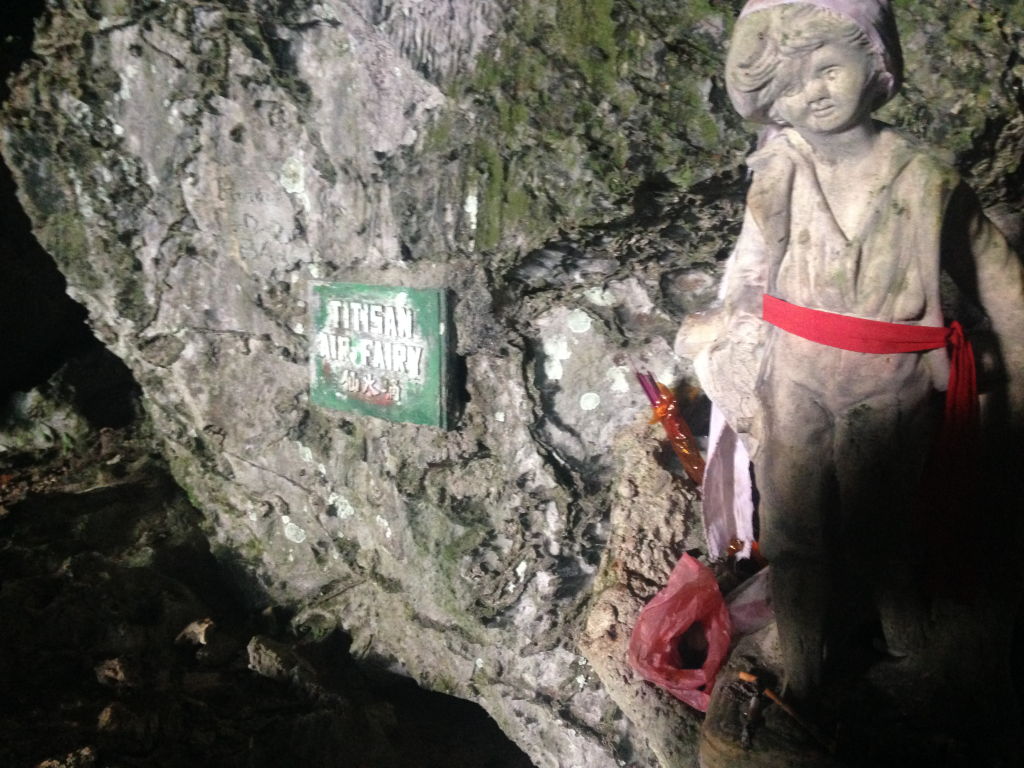

The weekend street market at Serikin had been recommended to us by a taxi driver who told us that traders from Indonesia cross the border every weekend to sell their wares (particularly Batik cloth) at bargain prices. To reach it we drove through a flat, rural district where the roads were bordered by lush banana or coconut plantations and fish farms. From the car park at Serikin Market, we could see stalls lining both sides of the long, crowded street.


They were displaying an array of handmade bowls, jewellery, musical instruments and authentic wooden souvenirs as well as the ubiquitous rolls of batik cloth. It’s a well-attended market and was thronging with people even in the heat of the midday sun. At the end of the street the stalls were packed with all kinds of exotic fruit and vegetables. Some of them had the produce laid out on the ground in attractive formations.

There were food items on display that we had never seen before and would have had no idea what to do with them, but almost every vendor urged us to buy something until we gave in and bought some strange-looking fruit that resembled chestnuts. Later, after they had been hanging around in the fridge for ages giving off a pungent aroma, we looked them up online and found out they are believed to aid fertility and are ‘an acquired taste’. We never did get round to cooking them! We also came away with some batik, a walking stick, pictured below with its owner and a few gifts to take home.

Keen to make the most of the car while we had it, we set off to get some of the heavier provision items on Monday morning (July 10th). Mydin Hypermarket is a fairly short drive from the fish farm and was blissfully deserted when we got there, so we were in and out quickly and back at the boatyard by midday. Paul took the car back to its parking place in the lane while I carried the shopping bags to the dinghy. Standing on the bridge while waiting for him to return, I heard the farm dogs barking furiously and when I turned my head to look, I saw the cause of it and could do nothing but gape. Two of the dogs were chasing a large crocodile off the premises, forcing it into the swampy mud at the edge of the water, just below me. It happened so fast and was so thrilling I didn’t even think to get my phone out to capture the scene. The dogs were right behind its long tail, one on either side and they didn’t let up barking until it flopped into the water and swam off. I watched it until it was out of sight and thought of all the times we had crossed the short stretch of water in the dinghy when it could have been perilously close. I understood the need for signs warning people to beware of them now; we would need to keep a sharper lookout in future. After returning the car later that evening, we spent the next few days on the boat catching up on various tasks. I didn’t see any more crocodiles during our time there – in or out of the water – but I feel privileged to have seen that one.

THE RAINFOREST FESTIVAL
Sarawak’s 20th Rainforest World Music Festival took place from the 14th-16th July and we had tickets for the opening day. It was to be our final excursion before leaving Santubong and despite not being a fan of world music, I was looking forward to attending the festival in the Cultural Village. I had been up for walking the whole way there – it is possible to do it- but the early afternoon heat was making us flag before we had got very far along the road. Paul was correct in surmising that someone would stop to offer us a lift. Our saviours were a young couple on their way to the festival, who kindly drove us as far as the park and ride spot and even offered us some of their stash of cold cans of beer. From the park and ride site it was only a 30 minute walk to the festival and we chose to do that rather than pay to get on the crowded shuttlebus to the venue. At the entrance, our bags were searched as we expected, but this being Borneo it was without the grim-faced officialdom often found at some events’ security gates. The staff were clearly enjoying the festival atmosphere and wanted everyone to have a good time: the smiles and greetings here were genuine.


The site looked totally different from our previous visit. It wasn’t overcrowded but there were lots more people, while colourful tents, stalls and cafes lined the village pathways. There was a lot going on and it was hard to decide what to do first, so we walked around the perimeter, browsing the stalls and checking out the variety of food for sale. Thankfully, alcohol wasn’t banned as I’d half expected it to be. Beer and wine were available, although typically prices were hiked up, it being a festival. Several workshops were dotted around the site, offering lessons or opportunities to make and play musical instruments and to create jewellery, clothes and woodcarvings from local materials. The bands weren’t due to take the stages until the evening so we spilt up for a couple of hours so that we could have a look around separately. Paul went off to watch some performances in the Chinese theatre while I browsed more of the art and craft stalls.

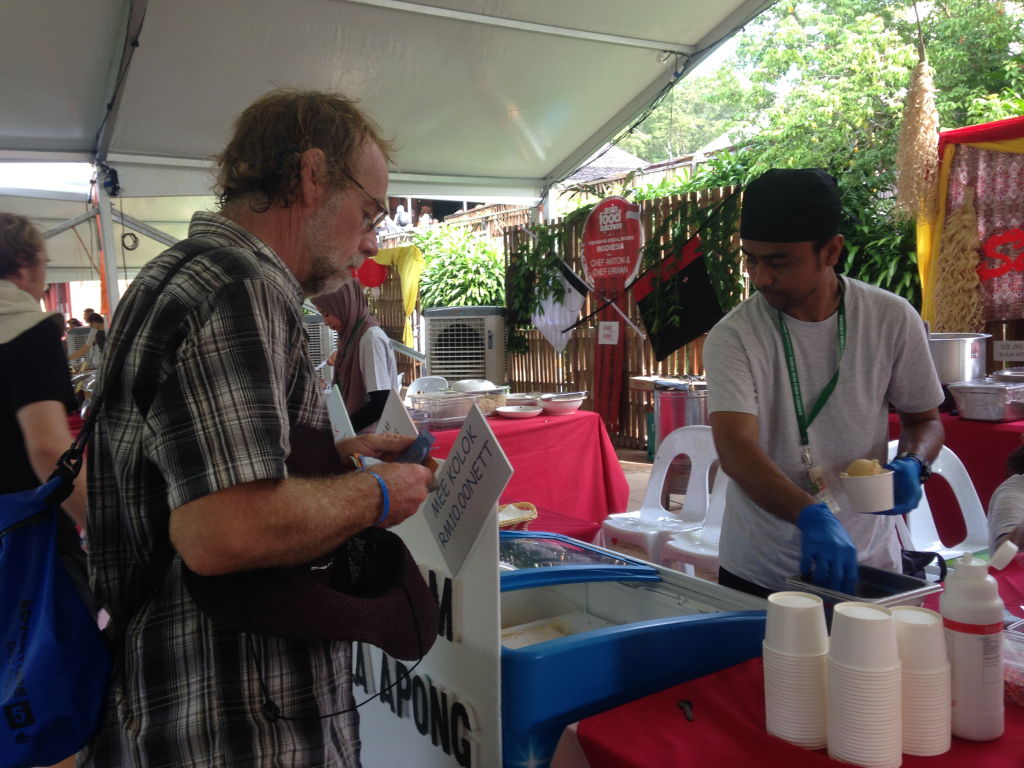

Dancers in flamboyant costumes, their faces painted with vivid colours, provided lively entertainment on the walkways, accompanied by music from musicians playing traditional instruments. It’s easy to see why the festival’s popularity has grown over the years. The emphasis is on music, culture and dance. There is no bureaucracy, no political speeches and the atmosphere is very relaxed. I couldn’t fault it in any way, although I did have a few moments of concern.
A traditional Iban opening ceremony was performed before the main events commenced. A man in traditional costume entered the main stage and began chanting while holding a placid-looking rooster. Behind him, people were swaying to the beat of the music and it was all beginning to look and sound decidedly sacrificial to my mind. I thought it best to close my eyes until it was all over – a tactic that has served me well when watching horror films or on vertigo-inducing fairground rides. Apparently a series of blinding flashes and loud bangs distracted the audience sufficiently to make the rooster’s fate uncertain! I’ll go with Paul’s opinion that it was all just theatre. I found out later that it was the Miring ceremony, and is performed to honour gods, spirits and ancestors and to wish the festival success. Sometimes the ritual involves the slaughter of a pig or a chicken, but while the pig is almost always killed, the chicken is often allowed to live – at the whim of the warrior.
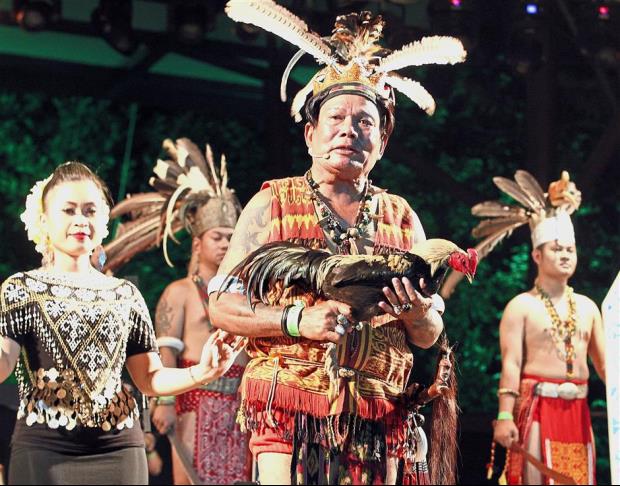
After that, it was all about the music. As the sun set behind the jungle stage we watched bands from Sarawak, Finland, Hungary and South Africa. The highlight for me was the Finnish band called Okra Playground who played a cracking ‘folk-rock’ session using traditional Finnish instruments, and judging by the crowd’s enthusiastic reaction I wasn’t alone in my admiration.

The African music that followed them didn’t do a lot for me, however, and as we had an early start planned in the morning we were ready to leave by then anyway. The festival was a spectacular event and it wouldn’t have taken much persuasion for me to stay for the next two days, but it was time to move on. We had a six day journey ahead of us to reach the marina at Miri where we would be leaving Sister Midnight for two months.
PASSAGE TO MIRI
We left Santubong on Saturday 15th July. With a slight hangover due to a bit too much festival wine, I watched the fish farm fade into the distance behind us as we motored over the shallows of the river and out into the sea. I was sad to leave. The serene tranquility of the anchorage at Santubong would be hard to beat, even with the addition of the crocodile. I will miss the dogs, too. We made our way to Pulau Lakei, and from there to Rajang in two fairly uneventful trips apart from slight seasickness due to the pitching and tossing of the waves. The journey from Rajang to the Paloh River began with the unpleasant task of having to scrub the caked on mud from the anchor chain. When Paul had scrubbed it, I was poised in the anchor locker to flake as usual and the smell of ‘stale’ fish coming from the chain was overpowering and nausea-inducing. This was a short passage, but it took a long time because of the route we had to take in order to avoid sandbanks. For a large part of the journey the depth hardly got above 5.5 metres and the water was very murky.

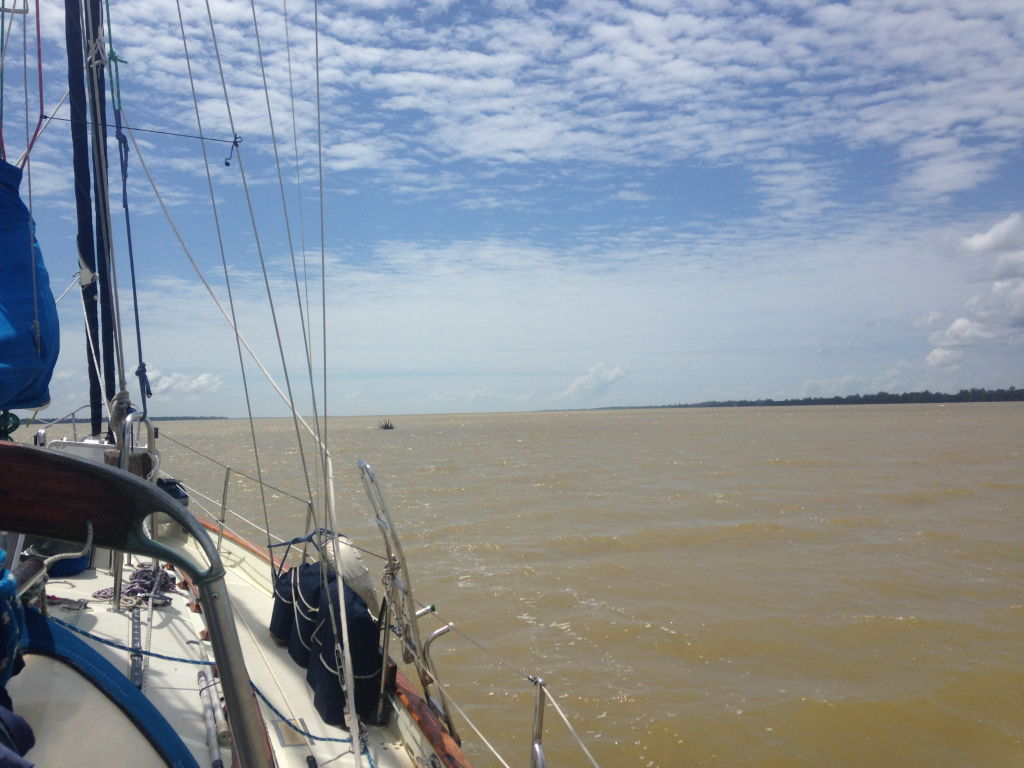
The following day we set off for Patok at 9 am to catch the tide. Soon we were meandering around the curves of the Paloh River. Iban longhouses are located on these lowland riverbanks of Borneo’s rainforest. I had read that it’s possible to make arrangements to visit certain ones and to talk with the families who still live in them. Next time we are in the area we might plan ahead and do that; they have a fascinating history and culture and love to tell people about it. There was no wind but the current helped us make good progress throughout the afternoon. When we anchored, it was so shallow that for the first time, I didn’t have to reverse with the engine to set the anchor. Paul just dropped it in 3.5 metres of water and let the current pull it tight.
Wednesday 19th July was the start of a two-night passage to finish our journey to Miri. The first day was straightforward. Few other boats were around and the sea was flat calm. I took my usual 8pm until midnight watch and used the radar to assess the proximity of nearby fishing boats. We had hoped to save fuel by using the sails on this passage but the lack of wind prevented it unfortunately. The main hazards to avoid were oil rigs, disused oil well heads near the surface, and unlit fishing boats. The radar is a great comfort to me on these occasions.

On the second evening, we had company in the form of a little bird (a swallow I think). It flew around the stern for ages before settling on the solar panels and there it stayed for a good few hours. I remarked that birds are sometimes associated with myths and omens regarding boats. That very afternoon I’d been rereading the poem The Ancient Mariner. Paul’s dry response went something like…‘it’s just a tired bird having a rest and might even be dead by morning!’ 🙂
‘Look out for a seahorse!’ was the instruction Paul yelled out above the wind as we drew nearer to Miri on July 21st. Over the years, I’ve been asked to look for green, red and yellow lights and marker buoys among other things but never a seahorse. The seahorse sculpture (Miri’s mascot) is situated on a spit of land that forms the breakwater of the harbour and serves as a marker for sailors to aim for. I spotted the unmistakeable shape of its head as it gradually came into view, although it took a while for Paul to recognise it as a seahorse.



We intended to anchor outside the marina until the tide was suitable for us to tackle the very shallow entrance into the marina itself. As we got closer, the sea, which had been pretty rough on our early morning approach, got choppier. Huge waves rocked us around like a bucking bronco, just as the sun came up and the area was very busy with marine traffic. Ferries, tugs and industrial vessels were going back and forth frequently from the marina even at that early hour. Anchoring was clearly out of the question in these conditions but we were aware that the sandbar at the entrance could make it very tricky if conditions weren’t right. For an hour or so we circled around dodging ships and big waves while I craved coffee and solid ground. Still undecided about when would be best to enter, Paul called the manager of the marina, a Captain Finn, who told him it would be fine to come in right then. We waited for a gap in the traffic and slowly edged Sister Midnight over the sand bar, watching the depth sounder drop to an alarming (for me anyway) 2 metres. Luckily the marina wasn’t very full and the waves died down once we were inside. Paul guided us in beautifully and I jumped down on to the pontoon and tied us off. We had a lot of sleeping and sorting out to catch up on before setting off on a proper inspection of our new surroundings but from a quick look around, it seemed lovely. It’s peaceful, sheltered and secure, with shower and toilet facilities – although no shops, bars or cafes. Later, we were welcomed by some of the marina’s other residents who were keen to offer tips and directions regarding where to eat and how to get into town etc. They were also able to confirm how secure and peaceful the marina is. In a little over a week we would be leaving our ‘home’ in SE Asia and it was good to know there would be people around to keep an eye on her for us. Some pics below show the parts of Miri we have seen so far.



